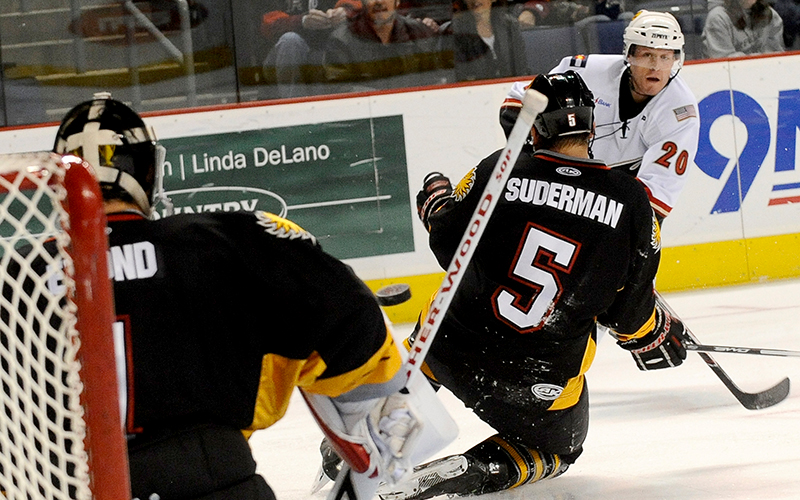
Many fans of the Arizona Sundogs long for professional hockey to return to Prescott Valley.
They enjoyed cheering on such players as Jon Landry before the team folded in 2014. (Photo by Mark Leffingwell/Digital First Media/Boulder Daily Camera via Getty Images)

Goaltender Marco Edmond (left) and Matt Suderman (center) were among the players that competed for the Arizona Sundogs during their eight seasons in Prescott Valley. (Photo by Mark Leffingwell/Digital First Media/Boulder Daily Camera via Getty Images)
PRESCOTT VALLEY – Tucked away in the city’s center is the Findlay Toyota Center, an arena known to many for housing the NBA G League’s Northern Arizona Suns. But not too long ago, it was the home of the Arizona Sundogs, a professional minor league hockey team that brought together a community.
The Sundogs played their last game in 2014, but the team’s banners still hang in the rafters of the place then known as Tim’s Toyota Center, which features suites filled with team jerseys and photos.
Many in Prescott Valley hope to see hockey return.
“As soon as they announced they were coming to town in ’06, I was immediately a fan,” said Jennifer Michael, president of the Arizona Sundogs Booster Club. “I was a hockey fan growing up. I grew up in LA. I was just ecstatic from the word go.”
The Sundogs were an affiliate of the NHL’s Colorado Avalanche during the 2006-07 season and for the then-Phoenix Coyotes for two seasons in 2007-09.
Many Central Hockey League teams were located in secondary markets that didn’t have many professional teams around. Prescott Valley was no different.
“There’s just that draw, especially with hockey, where you have parts of the game that are unique, like the fighting,” said Shane Cadwell, the general manager of Findlay Toyota Center. “You can’t get away with that in other sports. So it’s a pretty interesting thing, and I know that was a big part of the areas where I’ve been that have had Central Hockey League teams. They were so crucial to the towns because of that emotional attachment.”
That emotional attachment was the foundation of the fanbase. As soon as it was announced the team was coming to Prescott Valley, contests were held to name the newest CHL team.
The winner, Sundogs, refers to an optical phenomenon that results in a bright spot on one or both sides of the sun, caused by the refraction of sunlight by ice crystals in the atmosphere.
When the team won the Ray Miron Cup, the trophy awarded to the CHL playoff champion, in its second season, the city was jubilant.
Michael helped found a booster club to form a bridge between the most diehard fans and the players. Whenever players needed help, whether it was support during an injury or a sitter for pets during away games, Michael and fellow boosters were available.
“My husband and I would so often have the players over and would feed them,” said Sharon Stucynski, the booster club’s vice president. “Most of them are single guys, some are married, but most of them could have used a home-cooked meal. That’s what I enjoyed doing for our team.”
On Aug. 8, 2014, the team announced it was shutting down operations because of finances. Majority owner Brad Fain, in a statement, said, “In life we must learn to be all-in emotionally while at the same time, be dispassionate enough to realize the importance of being economically sustainable.”
Many fans “were crushed,” Michael said.
“The whole idea was, we wanted to get out of the CHL because the CHL was the bottom rung. It was the bottom level as far as climbing up. We didn’t have as much opportunity for the guys to be able to get out and get into the NHL, and if we could have got out, it brought more opportunity, more pay, it brought more talent and more skill, which obviously would have brought our community together even more.”
The desire to have a team in Prescott Valley didn’t die with the Sundogs. Some locals still hope to revitalize interest in the sport and bring hockey back.
“I got the news here when we were fighting to get the Coyotes’ AHL team here before they went to Tucson,” Michael said, referring to the Roadrunners. “We wanted the Coyotes and, of course, the (NHL’s) Golden Knights out of Vegas to know that we’ve got the fan base. The best part was that we are so close to either one that if they needed a player we could have them there in a couple hours.”
Prescott Valley still would like a team, Michael said. In 2016, the city supported fans’ attempt to lure the Roadrunners, an American Hockey League affiliate of the Coyotes that instead located in Tucson.
One of the biggest factors in deciding where a team will play is population, something Prescott Valley lacked. The U.S. census estimates Tucson’s population at 545,975 and Prescott Valley at 45,751.
But Cadwell believes Prescott Valley is in a better position now to secure and support a hockey team.
“When you’re trying to identify the best market to bring in your team, you look at all the factors that give you the best chance of success,” he said. “I would certainly think we would be in the mix for a future team, but those would be some of the key factors a potential ownership would be going through – ability to sell tickets, ability to sell sponsorships. Those are the key aspects, and you have to be able to project what the next five years will look like, even the next 10.”
Although the future of hockey in Prescott Valley is uncertain, the excitement the Sundogs generated still lingers.
“I miss it so much,” Stucynski said. “It was a place to go to be enjoyed, be entertained, visit your friends and watch the game and root for your team, definitely root for your team.”
A lot can be said about a team based on how loud their support base is. Some Arizona Sundogs fans believe they can still hear the cheers in the echoes of the Findlay Toyota Center.
